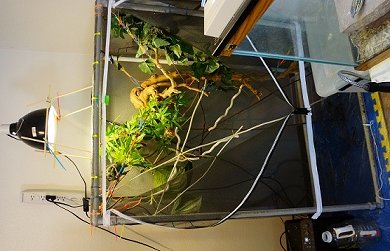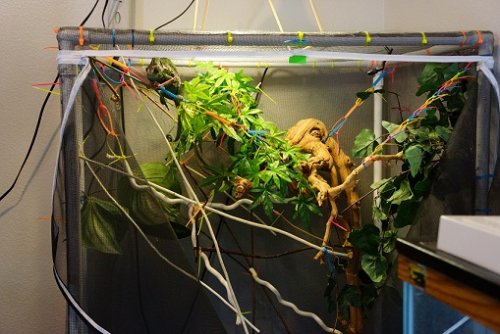LyraRose
New Member
Hi, I am brand new to this forum and I've only just joined because I wanted to know if a swollen casque is a serious problem that I should take my guy to the vet for.
I read somewhere else on this forum that a swollen casque might be due to the fat storage caused by over-eating however that would not make much sense in this case because there have been two adult dubia roaches in my cham's feeding bowl and I put those in the bowl about 2 days ago. So I'm fairly certain that neither of my veileds have eaten these past two days. Also, my female does not appear to have a swollen casque at all.
Problem: Swollen casque on adult male Veiled Chameleon
Size/color: the swollen area should be visible in the attached photo and does not appear discolored in any way
Texture: I would have felt the swollen area except Pascal (my male) is pretty aggressive and attempts to bite my fingers any time they get close to him. (And I know he's not just bluffing, he's gotten my fingers pretty good in the past)
Any suggestions as to what could be going on?
I read somewhere else on this forum that a swollen casque might be due to the fat storage caused by over-eating however that would not make much sense in this case because there have been two adult dubia roaches in my cham's feeding bowl and I put those in the bowl about 2 days ago. So I'm fairly certain that neither of my veileds have eaten these past two days. Also, my female does not appear to have a swollen casque at all.
Problem: Swollen casque on adult male Veiled Chameleon
Size/color: the swollen area should be visible in the attached photo and does not appear discolored in any way
Texture: I would have felt the swollen area except Pascal (my male) is pretty aggressive and attempts to bite my fingers any time they get close to him. (And I know he's not just bluffing, he's gotten my fingers pretty good in the past)
Any suggestions as to what could be going on?

![DSC01197[1].jpg](/data/attachments/43/43981-11bd82f14925d371224ab0498a1ced60.jpg)
![DSC01199[1].jpg](/data/attachments/43/43985-eb2c5e60f46e6ebdb7c4edc2b6b30cae.jpg)





